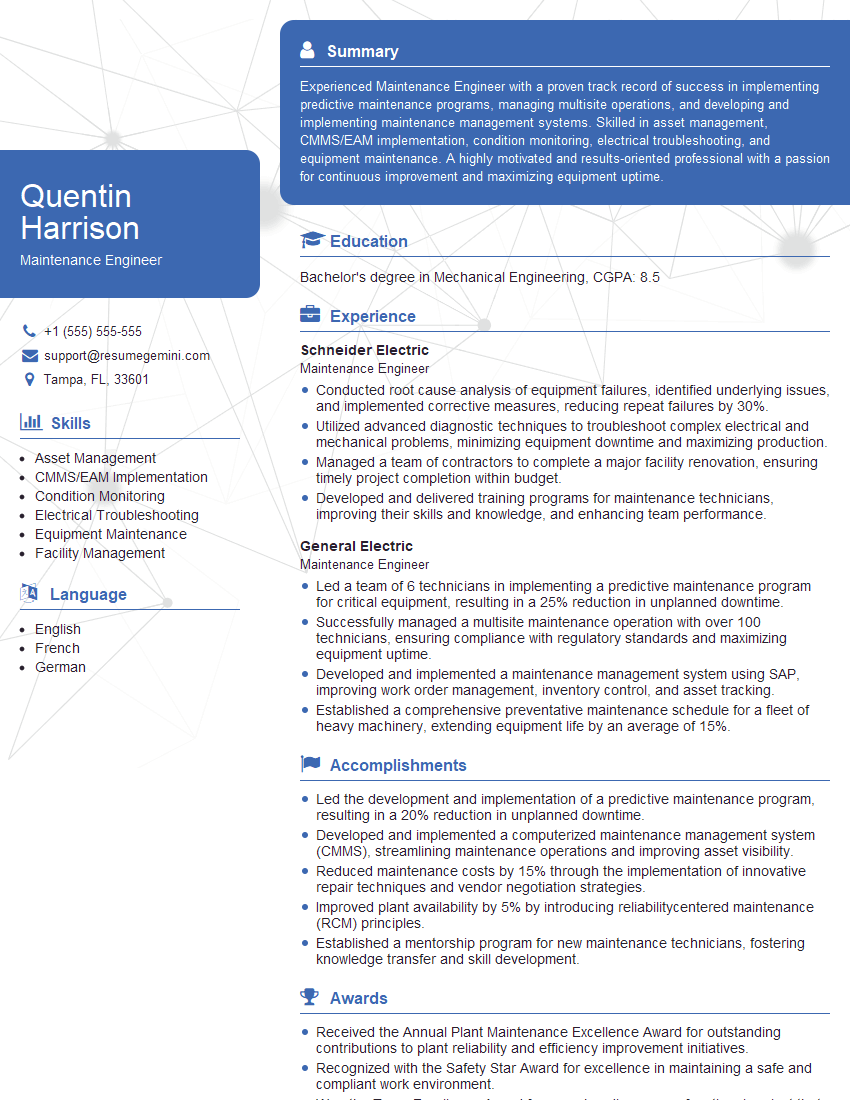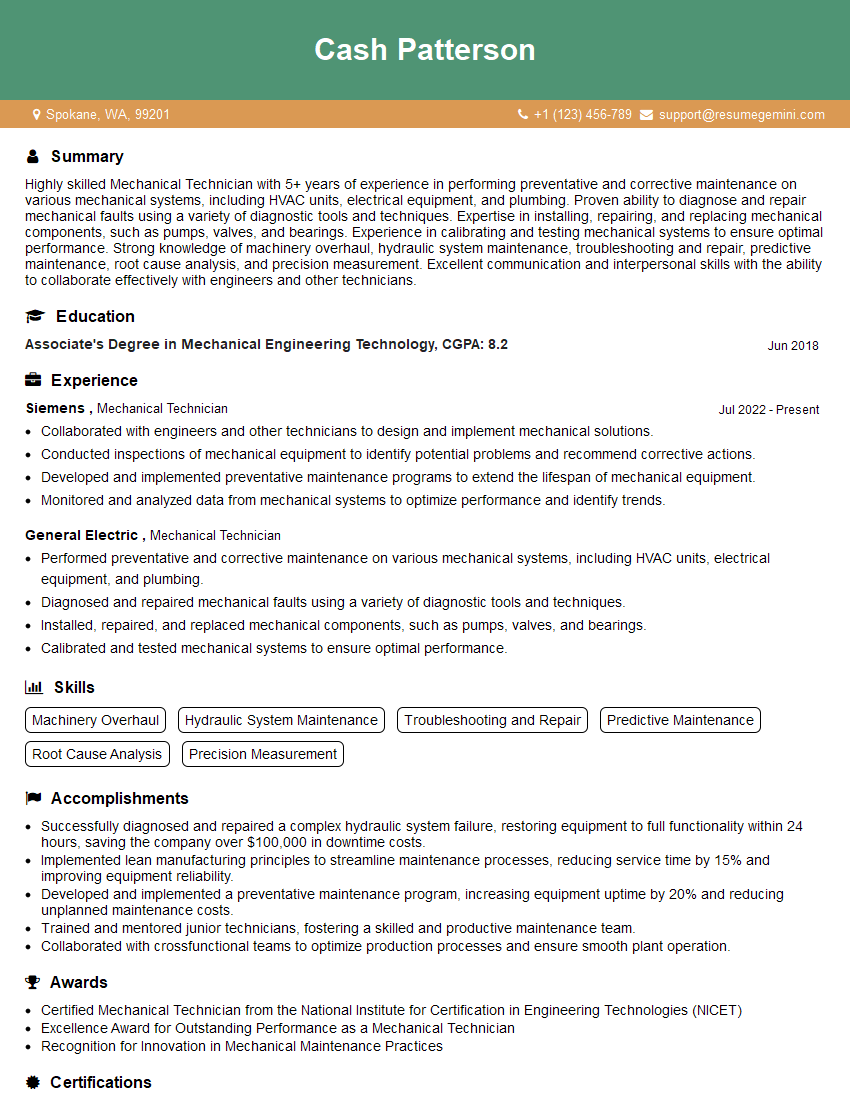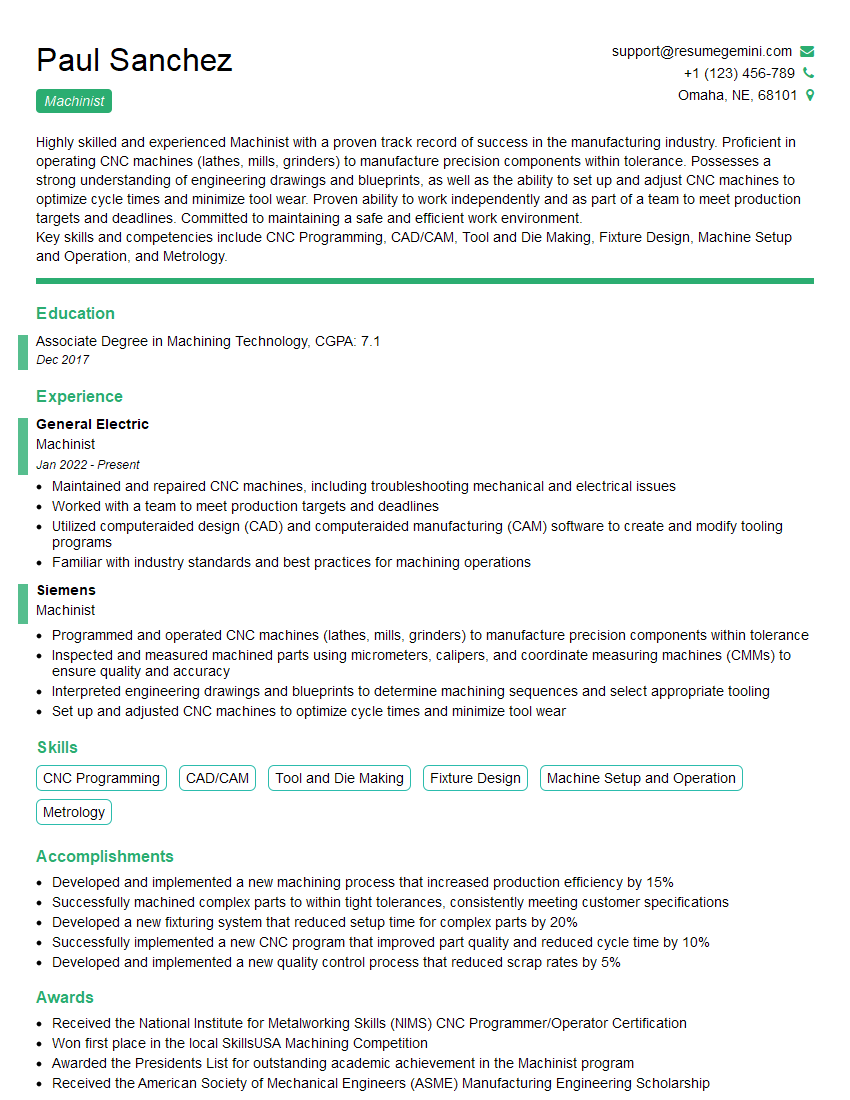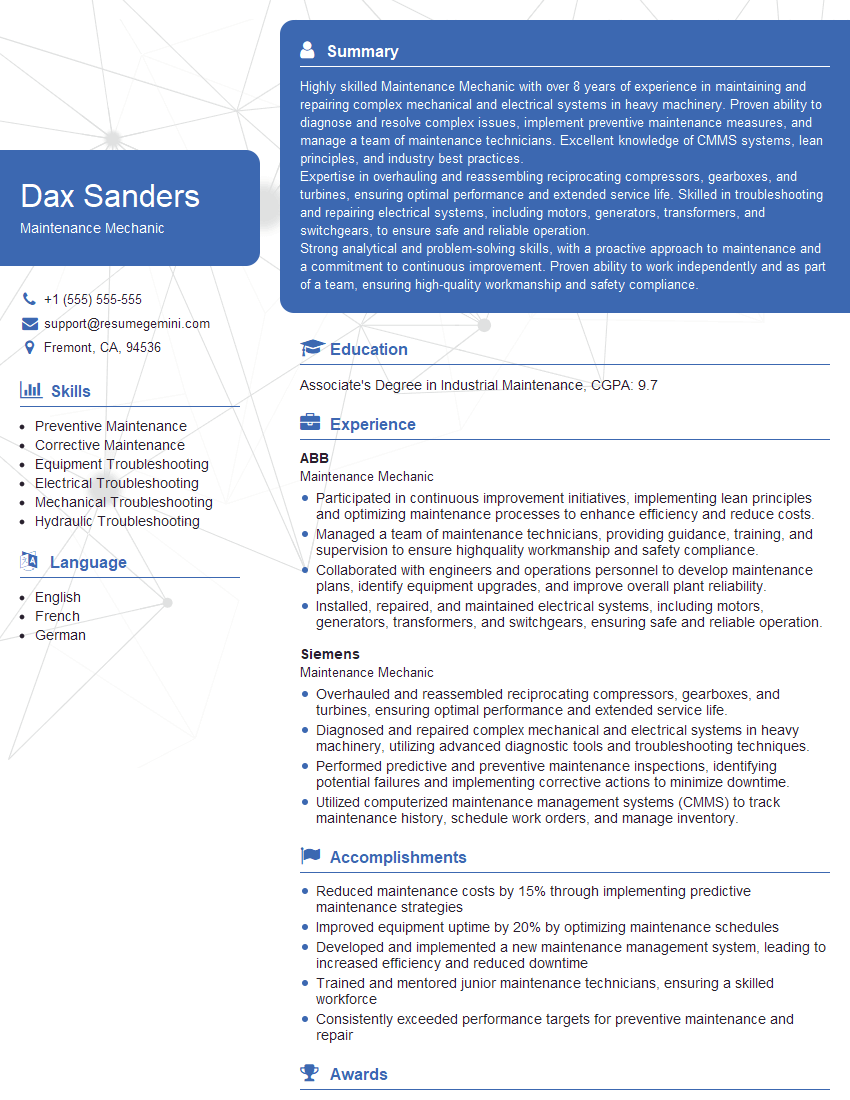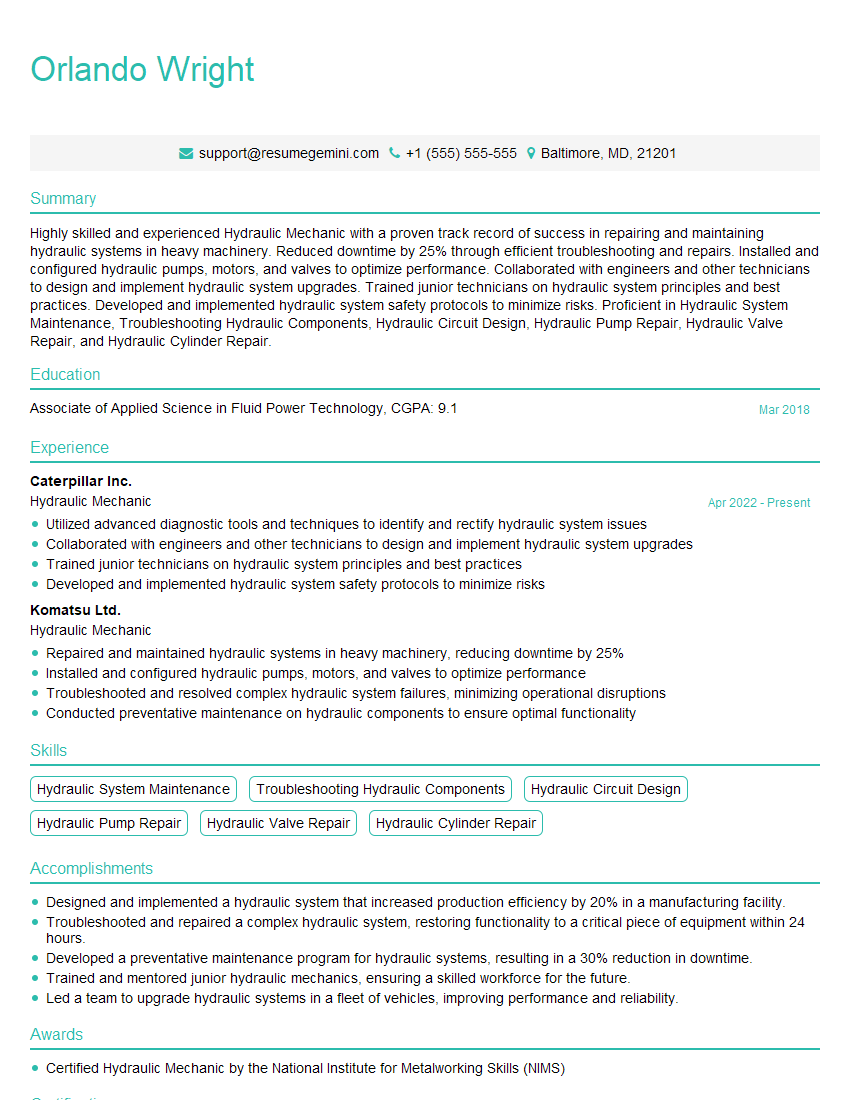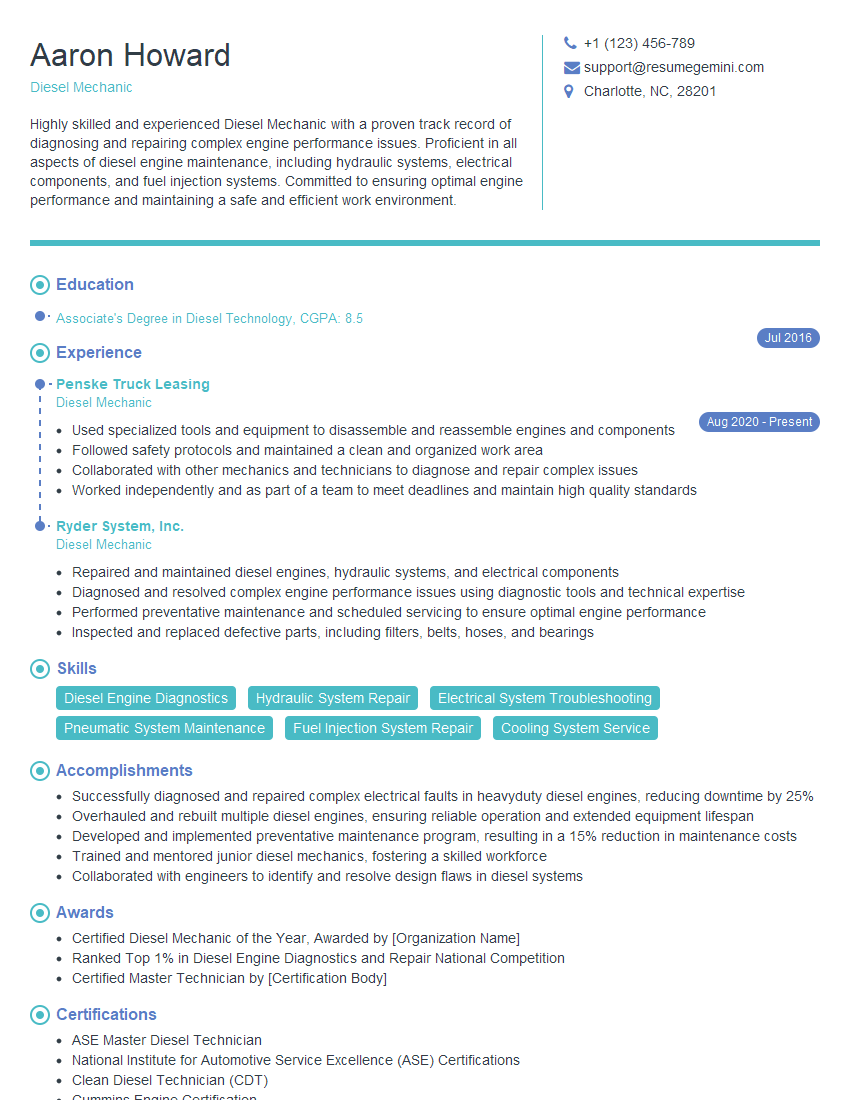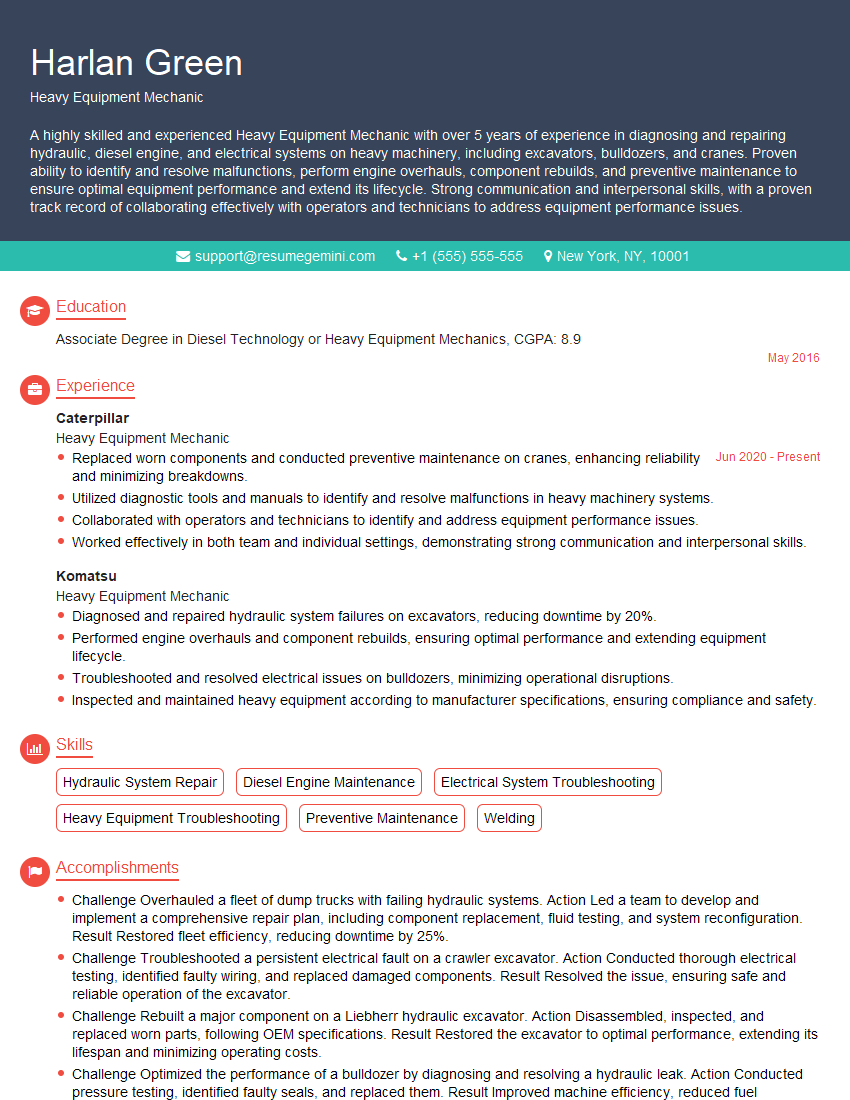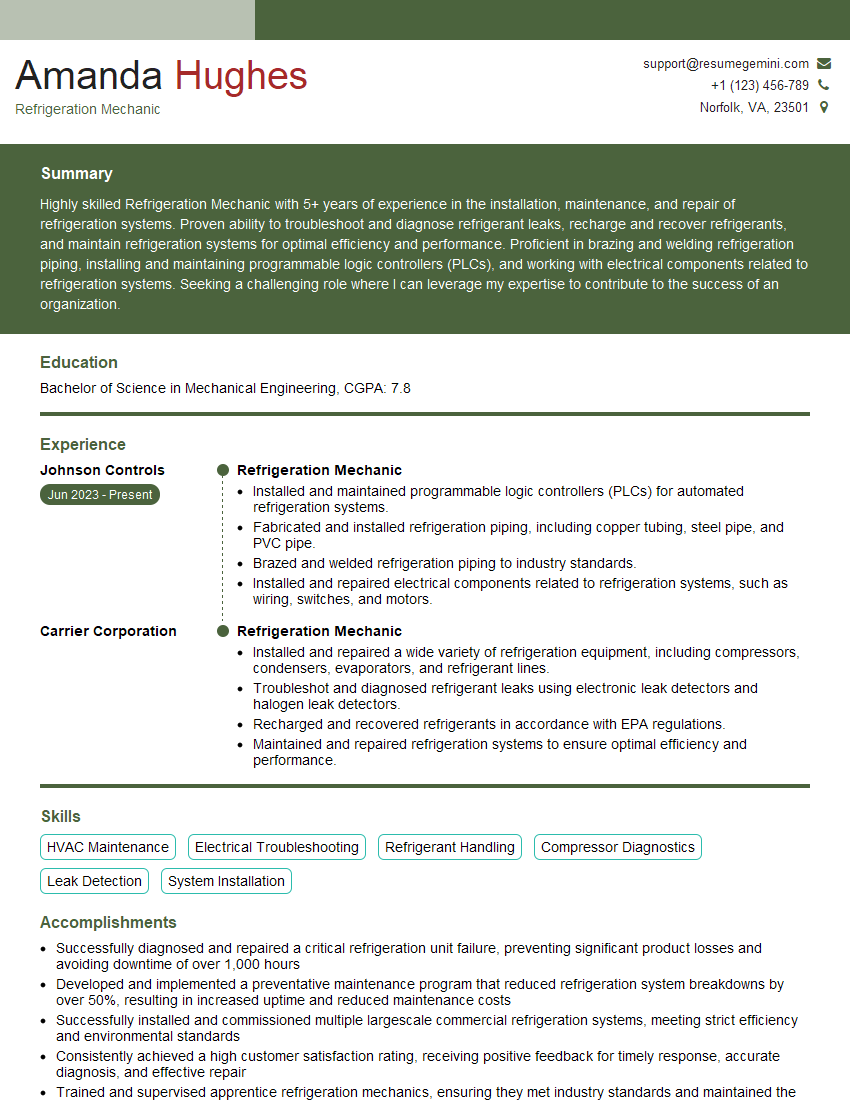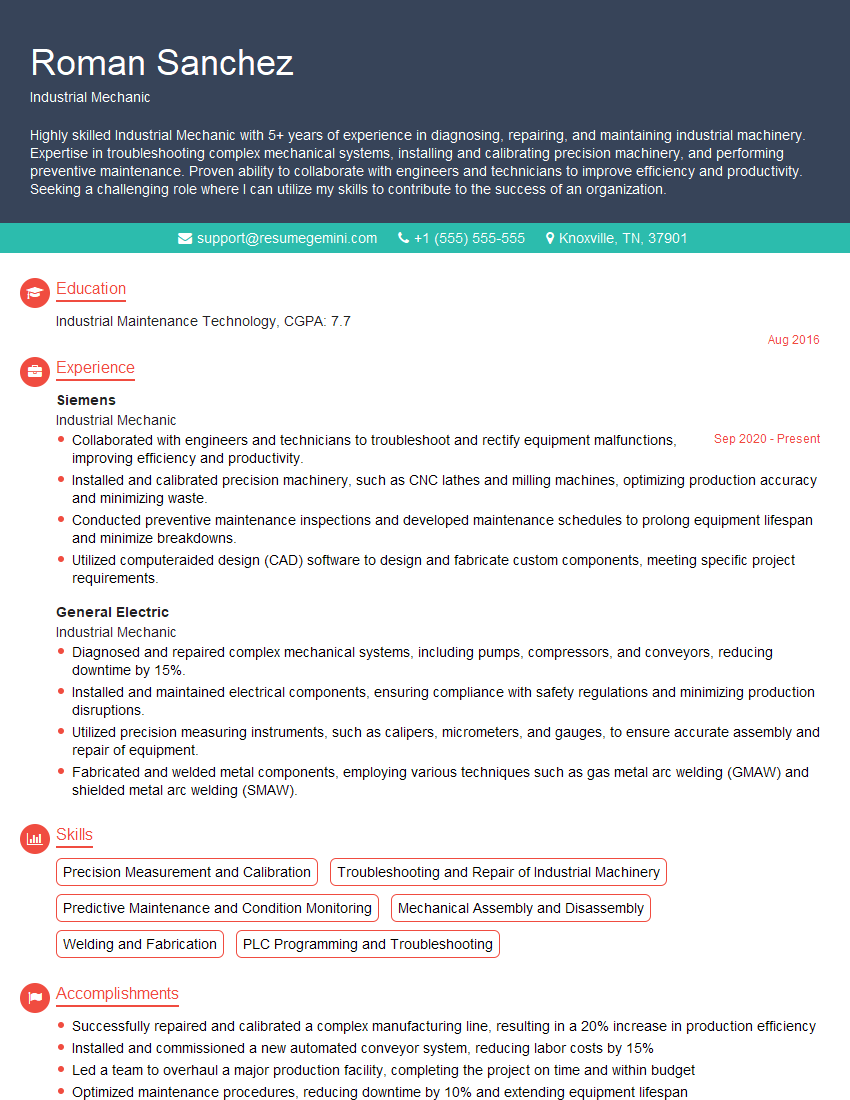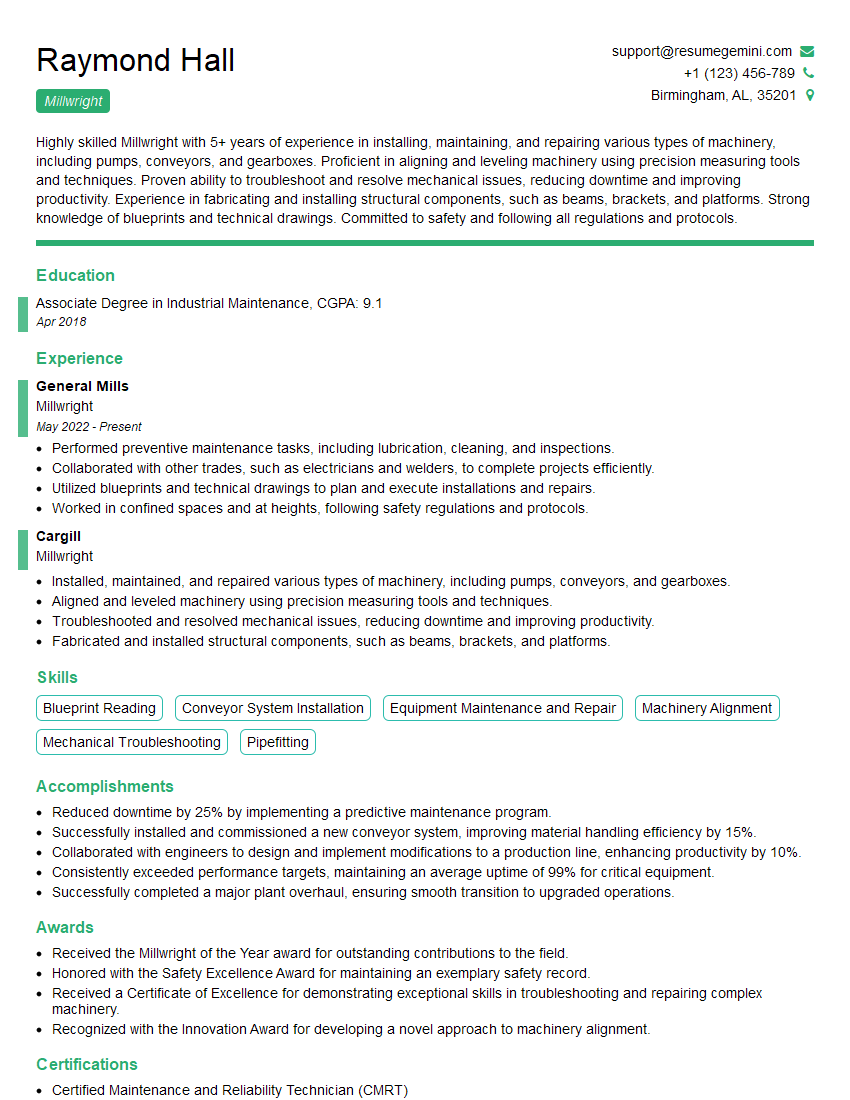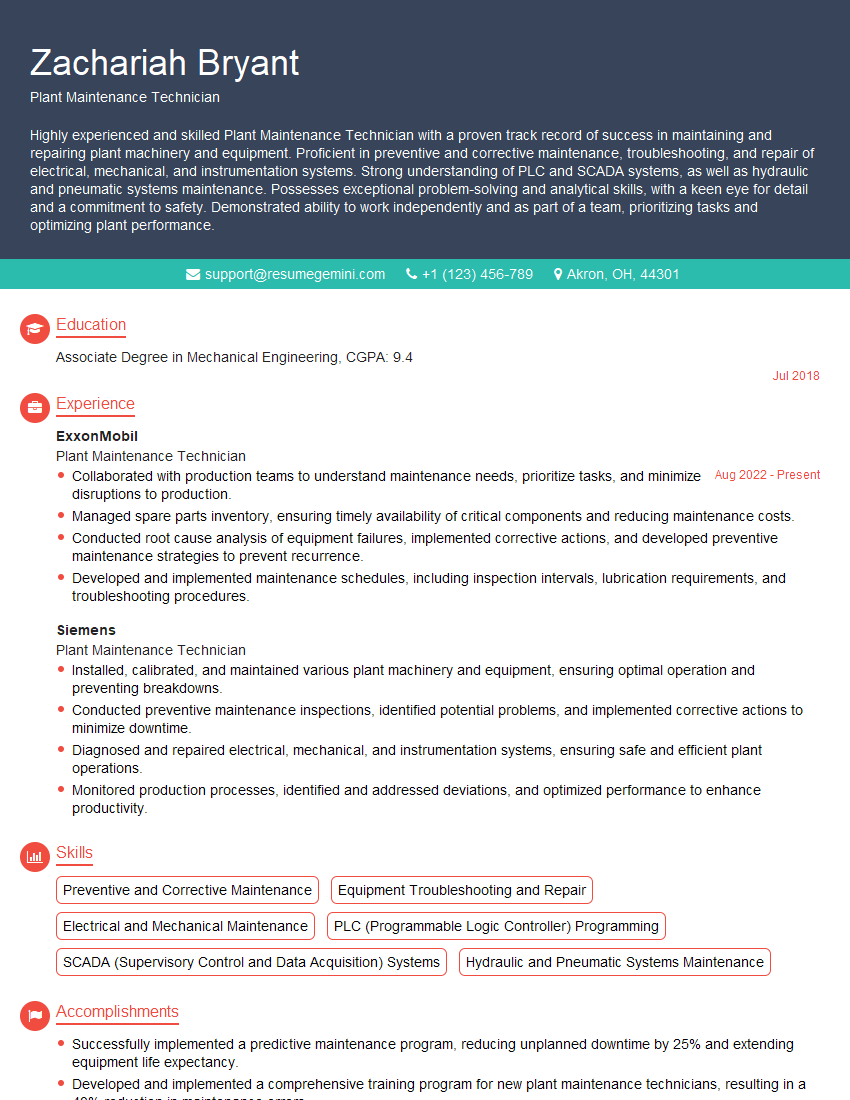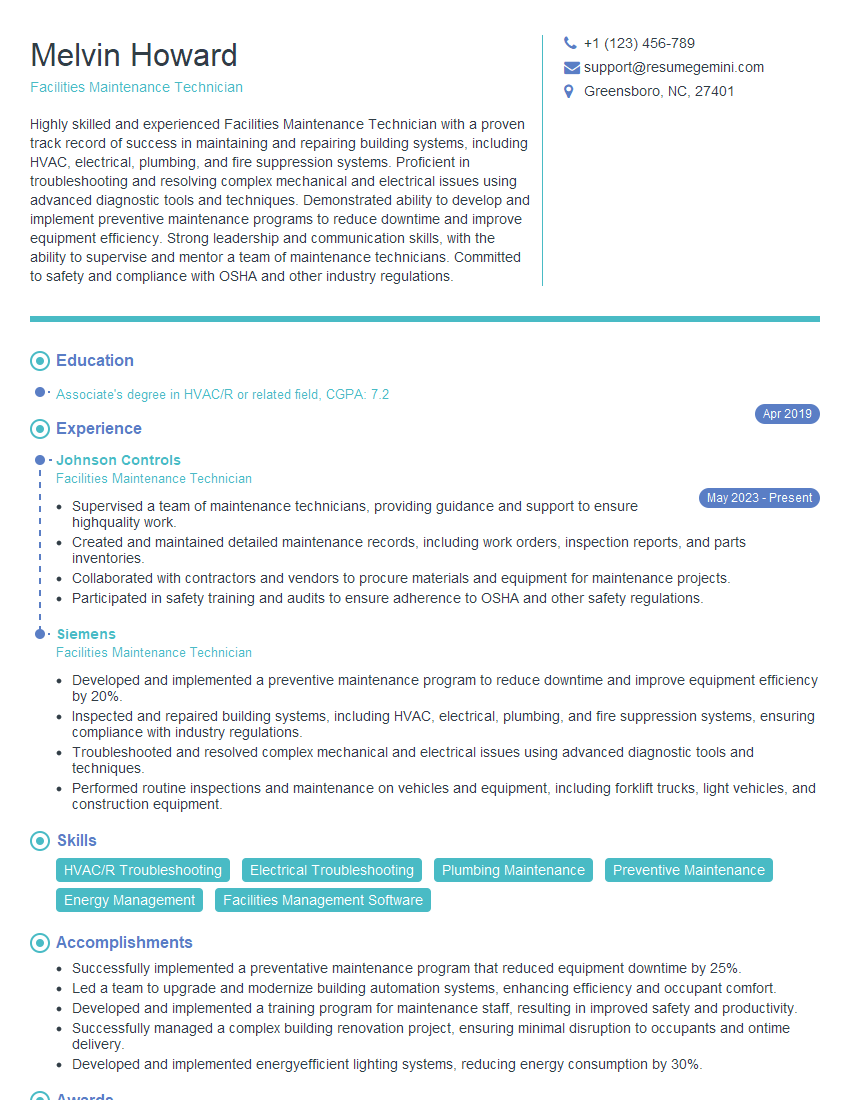Interviews are opportunities to demonstrate your expertise, and this guide is here to help you shine. Explore the essential Mechanical Equipment Repair interview questions that employers frequently ask, paired with strategies for crafting responses that set you apart from the competition.
Questions Asked in Mechanical Equipment Repair Interview
Q 1. Explain the troubleshooting process for a malfunctioning hydraulic system.
Troubleshooting a malfunctioning hydraulic system requires a systematic approach. Think of it like detective work – you need to gather clues and eliminate possibilities until you find the culprit. The process typically begins with a visual inspection, checking for leaks, loose connections, or obvious damage.
- Safety First: Always ensure the system is properly isolated and depressurized before starting any troubleshooting.
- Check for Leaks: Inspect all hoses, fittings, and seals for leaks. A small leak can lead to significant system failure over time. A soapy water solution can help visualize leaks.
- Examine the Hydraulic Fluid: Check the fluid level and condition. Dirty, contaminated, or low fluid levels can severely impact performance. Note the color and consistency – milky fluid suggests water contamination.
- Test Pressure and Flow: Use gauges to measure the system pressure and flow rate. Compare these readings to the manufacturer’s specifications. Low pressure might point towards a pump issue, while restricted flow could indicate a clogged filter or valve.
- Inspect Components: Systematically check each component, including the pump, valves, actuators (cylinders), and filters. Listen for unusual noises – a whining pump, for instance, could signify wear.
- Operate the System: If safe to do so, operate the system to observe its behavior and pinpoint the point of failure. Does the actuator move correctly? Are there any unusual sounds?
- Use Diagnostic Tools: Specialized tools like pressure transducers, flow meters, and particle counters can provide more precise measurements and data for accurate diagnosis.
For example, I once worked on a hydraulic press where the ram wouldn’t extend. After carefully checking, I discovered a small crack in the hydraulic line, causing a significant pressure drop. Replacing the line quickly solved the problem.
Q 2. Describe your experience with preventative maintenance schedules.
Preventative maintenance schedules are crucial for maximizing equipment lifespan and minimizing downtime. I’ve developed and implemented schedules for various types of machinery, always tailoring them to the specific equipment’s operating conditions and manufacturer’s recommendations. These schedules usually include a combination of:
- Regular Inspections: This involves visual checks for wear, tear, leaks, and loose connections. Frequency depends on the equipment’s criticality and operating environment – more frequent for heavy-duty equipment in harsh conditions.
- Lubrication: Regular lubrication of bearings, gears, and other moving parts reduces friction, wear, and extends equipment life. The type and frequency of lubrication depend on the equipment and its components.
- Fluid Changes: Hydraulic fluids, lubricants, and coolants degrade over time. Regular changes are essential to maintain optimal performance and prevent component damage. This also involves checking for contamination.
- Component Replacements: Some components have a finite lifespan and need planned replacement to prevent unexpected failures. For example, filters, belts, and seals have predetermined replacement intervals.
- Functional Testing: Periodically test the equipment’s functionality to ensure it meets the required performance specifications.
For instance, in my previous role, I implemented a preventative maintenance schedule for a large conveyor system. This involved a weekly lubrication schedule, monthly visual inspections, quarterly functional testing, and yearly belt replacements. This proactive approach significantly reduced unscheduled downtime and maintenance costs.
Q 3. How do you diagnose bearing failure in rotating machinery?
Diagnosing bearing failure in rotating machinery involves a combination of visual inspection, listening for sounds, and using vibration analysis.
- Visual Inspection: Look for signs of overheating (discoloration), damage (pitting, spalling), or excessive wear on the bearing housing. Check for any signs of lubrication leakage.
- Acoustic Inspection: Listen carefully for unusual noises. Grinding, squealing, or rumbling sounds often indicate bearing problems. The type of noise can offer clues about the specific issue. A high-pitched squeal may suggest lack of lubrication, while a grinding sound may mean significant damage.
- Vibration Analysis: This is the most effective method for early detection. Vibration analysis involves measuring the amplitude, frequency, and phase of vibrations using sensors and specialized equipment. Abnormal vibration patterns, particularly increases in amplitude and specific frequencies, are strong indicators of bearing damage. The location and frequency of the vibrations can help pinpoint the affected bearing.
For example, in a recent case, I used vibration analysis on a pump motor. High frequency vibrations detected via a spectrum analyzer pointed to an impending bearing failure. Replacing the bearing prevented catastrophic failure and avoided costly downtime.
Q 4. What are the common causes of motor overheating?
Motor overheating is a common problem with several potential causes:
- Overload: The motor is attempting to drive a load beyond its rated capacity. This could be due to excessive friction, binding, or an unexpectedly high load.
- Insufficient Ventilation: Poor ventilation prevents heat dissipation, causing the motor to overheat. Dust buildup, blocked vents, or inadequate airflow can all contribute to this.
- Winding Problems: Short circuits, open circuits, or other internal winding problems can lead to excessive heat generation within the motor.
- Bearing Failure: Faulty bearings can increase friction, leading to heat generation and potentially motor overheating.
- Improper Wiring: Loose connections, high resistance in the wiring, or incorrect sizing of the wiring can cause overheating.
- Ambient Temperature: High ambient temperatures can exacerbate the motor’s heat buildup, pushing it past its operational limits.
To troubleshoot, systematically check each of these aspects. Using a thermal imaging camera can quickly pinpoint hot spots, helping isolate the problem area. For example, I once diagnosed a motor overheating issue caused by accumulated dust in the ventilation system; cleaning the system solved the problem.
Q 5. Explain the principles of vibration analysis in mechanical equipment.
Vibration analysis is a powerful technique for monitoring the health of mechanical equipment. It works on the principle that all rotating and reciprocating machinery produces vibrations. The characteristics of these vibrations – frequency, amplitude, and phase – change when a component malfunctions or wears out. Vibration analysis uses sensors to measure these vibrations, converting them into data that can be analyzed to identify potential problems.
- Data Acquisition: Sensors, often accelerometers, are mounted on the equipment. They measure vibrations in different directions (axial, radial, and tangential). Data is collected either continuously or at regular intervals.
- Signal Processing: The raw vibration data is then processed using techniques like Fast Fourier Transforms (FFT) to convert the time-domain data into the frequency domain. This allows identifying specific frequencies associated with particular machine components.
- Fault Diagnosis: By comparing the measured vibration patterns to baseline data (vibrations of a healthy machine) or known fault signatures, we can identify potential problems like imbalance, misalignment, bearing defects, gear wear, and looseness.
Think of it as listening to the machine’s heartbeat. A healthy machine has a regular, predictable vibration pattern, while a malfunctioning one shows irregular patterns. The frequency of the vibration can even tell you exactly which part of the machine is in trouble.
Q 6. Describe your experience with different types of welding.
My experience encompasses several welding types, each suited to different materials and applications:
- Shielded Metal Arc Welding (SMAW): Also known as stick welding, it’s versatile and relatively inexpensive, suitable for various metals. I have extensive experience with this method, particularly in field repairs where portability is key.
- Gas Metal Arc Welding (GMAW): Or MIG welding, known for its speed and efficiency. I’ve used this extensively for joining thinner materials and producing high-quality welds in automated applications.
- Gas Tungsten Arc Welding (GTAW): Also known as TIG welding, this process produces very clean, precise welds, especially useful for stainless steel, aluminum, and other high-quality materials. I’ve utilized this for intricate repairs and work requiring high-quality aesthetic finish.
- Flux-Cored Arc Welding (FCAW): This self-shielded process is ideal for outdoor and less-controlled environments, delivering good penetration. I’ve employed this method in situations with limited access and poor ventilation.
For example, I’ve used SMAW to repair heavy equipment on-site, utilizing its portability. In a workshop setting, I prefer GMAW or GTAW for their speed and precision depending on the material and required weld quality.
Q 7. How do you interpret engineering drawings and schematics?
Interpreting engineering drawings and schematics is fundamental to my work. I approach them systematically, using a combination of knowledge and tools:
- Understanding the Conventions: Familiarity with standard drawing symbols, notations, and conventions is essential. This includes understanding dimensioning, tolerances, material specifications, and other annotations.
- Identify Views and Sections: The drawings usually include multiple views (front, top, side) and sections to give a complete picture of the component or assembly. Understanding these views is critical for visualizing the part’s geometry and assembly.
- Analyze Bill of Materials (BOM): The BOM lists the components needed for assembly. This helps in ordering parts and understanding the relationship between different components.
- Utilize CAD Software: I often use CAD software (like AutoCAD or SolidWorks) to view and manipulate 3D models of components, making it easier to visualize the assembly and identify individual parts.
- Refer to Relevant Standards: Understanding and adhering to relevant industry standards and specifications is vital, ensuring the repair or maintenance is carried out according to the correct requirements.
For example, recently, I used engineering drawings and a parts list to diagnose the cause of a malfunctioning gear reducer. By carefully studying the cross-sectional view, I identified a worn gear tooth, which was then replaced, resolving the issue.
Q 8. What safety procedures do you follow when repairing equipment?
Safety is paramount in mechanical equipment repair. My approach is always guided by a layered safety protocol. It begins with a thorough risk assessment of the equipment and the task at hand. This involves identifying potential hazards such as exposed wiring, rotating parts, high-pressure systems, and hazardous materials. Then, I implement appropriate control measures. This could include locking out and tagging out energized circuits (LOTO), using personal protective equipment (PPE) like safety glasses, gloves, and steel-toed boots, and ensuring adequate ventilation in case of fumes or dust.
- LOTO Procedures: Before starting any work on machinery with electrical or hydraulic power, I meticulously follow lockout/tagout procedures to prevent accidental energization. This is a non-negotiable step.
- PPE Utilization: Appropriate PPE is selected based on the specific hazards identified during the risk assessment. This isn’t just about following rules; it’s about protecting myself and others.
- Confined Space Entry: If the repair involves working in a confined space, I ensure proper atmospheric testing for oxygen levels, flammable gases, and toxic substances, and use appropriate respiratory protection and safety harnesses.
Finally, I maintain a clean and organized workspace to minimize tripping hazards and improve overall safety. Safety isn’t an afterthought; it’s integrated into every step of the repair process. I once prevented a serious accident by discovering a hidden electrical fault during a routine inspection, before commencing repairs, preventing potential electrocution.
Q 9. Explain your experience with PLC troubleshooting.
My PLC troubleshooting experience is extensive. I’m proficient in diagnosing and resolving issues in various PLC platforms, including Allen-Bradley, Siemens, and Schneider Electric. My approach is systematic and utilizes a combination of diagnostic tools and techniques.
- Visual Inspection: I begin with a visual inspection of the PLC and its connections, checking for loose wires, damaged components, or signs of overheating.
- Ladder Logic Review: Next, I review the ladder logic program to identify potential programming errors or logic flaws. I use the PLC’s programming software to simulate program execution and troubleshoot any issues.
- I/O Testing: I verify the input and output signals using multimeters and other diagnostic tools. This helps to isolate problems to either the sensors/actuators (I/O) or the PLC itself.
- Communication Diagnostics: Network communication issues are often a culprit. I utilize network diagnostic tools to examine communication parameters, identify network faults and resolve connectivity problems between the PLC and other devices.
For example, I recently resolved a production line stoppage caused by a faulty proximity sensor. By systematically examining the sensor’s output signal and tracing it back through the PLC’s I/O system, I pinpointed the issue and replaced the faulty sensor, restoring production within an hour. My experience encompasses both hardware and software troubleshooting, ensuring a comprehensive approach to PLC problem-solving.
Q 10. How do you handle emergency repairs?
Emergency repairs require a rapid and effective response. My approach is centered around speed and safety, prioritizing the immediate restoration of functionality while mitigating further damage. I follow these steps:
- Assessment: I first assess the situation to understand the nature and extent of the damage and the potential safety risks.
- Prioritization: I prioritize the repairs based on criticality – addressing immediate safety hazards first, then focusing on restoring essential functions.
- Temporary Fixes: Often, a temporary fix is necessary to restore partial functionality while awaiting the arrival of permanent replacement parts. This might involve bypassing a damaged component or using a temporary patch.
- Documentation: Even in emergencies, meticulous documentation of the repair process, including the temporary measures implemented, is essential for future reference and analysis.
- Permanent Repair: Once the emergency is resolved, I proceed with permanent repairs, ensuring all components are functioning correctly and the system is safe and efficient.
I recall an instance where a critical pump failed unexpectedly during a night shift. By quickly assessing the situation, implementing a temporary bypass, and securing the failed pump to prevent further damage, I prevented a significant production loss and avoided a potential environmental hazard. The speed and efficiency of my response significantly minimized disruption.
Q 11. Describe your experience with different types of pumps.
My experience encompasses a wide range of pump types, including centrifugal pumps, positive displacement pumps (like gear pumps, screw pumps, and piston pumps), and diaphragm pumps. I understand their operating principles, common failure modes, and maintenance requirements.
- Centrifugal Pumps: I’m familiar with various impeller designs, net positive suction head (NPSH) calculations, and the importance of proper alignment and balancing. Issues often stem from impeller wear, seal failures, or cavitation.
- Positive Displacement Pumps: These pumps provide a consistent flow rate, making them suitable for applications requiring precise fluid delivery. I understand the intricacies of gear meshing, internal clearances, and the importance of lubrication in these pumps. Gear wear, seal leakage, and internal component failures are common issues.
- Diaphragm Pumps: Used for handling abrasive or viscous fluids, diaphragm pumps offer a gentler pumping action. I understand the importance of diaphragm integrity and the procedures for replacing worn diaphragms.
Recently, I diagnosed a problem with a gear pump in a chemical processing plant. The pump exhibited reduced output and noisy operation. Through careful inspection, I determined that the gears were worn and needed replacement. This involved disassembling the pump, replacing the worn gears, and reassembling it according to manufacturer’s specifications.
Q 12. What are the common causes of gear wear?
Gear wear is a common problem caused by several factors working together. These factors can be broadly categorized as:
- Lubrication Issues: Insufficient lubrication, improper lubricant viscosity, or contamination of the lubricant are major contributors to gear wear. Lack of lubrication leads to increased friction and accelerated wear.
- Misalignment: Improper alignment of gears causes uneven loading and premature wear, particularly on the gear teeth.
- Overloading: Exceeding the designed load capacity of the gears leads to excessive stress and wear. This can be due to unexpected surges in load or incorrect sizing of the gear system.
- Material Selection: Incorrect material selection for the application can lead to wear. Materials must be appropriate for the load, speed, and operating environment.
- Manufacturing Defects: Defects in the manufacturing process, such as inconsistencies in tooth profile or hardness, can predispose gears to premature wear.
For instance, I recently encountered excessive gear wear in a conveyor system. After careful investigation, I discovered that the lubricant had been contaminated with abrasive particles. Replacing the lubricant and implementing a more robust filtration system resolved the issue, preventing further damage.
Q 13. Explain the difference between preventative and corrective maintenance.
Preventative maintenance (PM) and corrective maintenance (CM) are two distinct approaches to equipment maintenance, with different goals and strategies.
- Preventative Maintenance (PM): This is a proactive approach that aims to prevent equipment failures before they occur. It involves regularly scheduled inspections, lubrication, cleaning, and adjustments to ensure the equipment operates within its design specifications. Think of it like regular check-ups for your car – preventing small problems from becoming major breakdowns.
- Corrective Maintenance (CM): This is a reactive approach that involves repairing equipment after a failure has occurred. It addresses the immediate problem and restores the equipment to its operational state. This is like fixing your car only *after* it breaks down.
A well-structured maintenance program combines both PM and CM. A strong PM program significantly reduces the need for CM, minimizing downtime, extending equipment lifespan, and reducing overall maintenance costs. Prioritizing preventative maintenance is far more cost-effective in the long run. I frequently advise clients to prioritize preventative maintenance, and have shown them the significant return on investment through reduced downtime and repair costs.
Q 14. How do you maintain accurate records of repairs and maintenance?
Maintaining accurate records is crucial for effective equipment management. I utilize a computerized maintenance management system (CMMS) to track all repairs and maintenance activities. This system allows me to:
- Record Details: Document each repair or maintenance task, including the date, time, equipment involved, problem description, actions taken, parts used, and labor hours.
- Track History: Maintain a comprehensive history of each equipment’s maintenance and repair activities. This aids in identifying recurring problems and trends.
- Generate Reports: Generate reports on maintenance costs, equipment downtime, and overall equipment effectiveness (OEE).
- Schedule PM Tasks: Schedule preventative maintenance tasks based on manufacturer’s recommendations and historical data.
- Manage Inventory: Track spare parts inventory and automate reordering when stock levels fall below a certain threshold.
Using a CMMS ensures that information is readily available, organized, and easily accessible, streamlining communication and improving decision-making. It allows for data-driven insights into equipment performance, enabling proactive maintenance strategies and optimized resource allocation. In the past, this method has significantly improved our team’s efficiency and reduced maintenance-related costs.
Q 15. Describe your experience with different types of lubricants.
My experience with lubricants spans a wide range, encompassing various types based on their base oil, additives, and application. I’m familiar with mineral oils, synthetic oils, greases, and specialized lubricants like those used in high-temperature or extreme-pressure environments.
- Mineral Oils: These are cost-effective and suitable for many general applications. However, their performance degrades faster than synthetics under extreme conditions.
- Synthetic Oils: Offer superior performance at high and low temperatures, extending equipment lifespan and reducing maintenance frequency. They are often used in precision machinery and demanding environments. For example, I’ve used synthetic oils in high-speed CNC machine spindles.
- Greases: Provide lubrication and sealing in applications where oil would leak, such as bearings. Different greases exist with varying consistency (NLGI grades) and additive packages for different operating conditions. I’ve had experience selecting the correct grease type for conveyor system bearings based on operating temperature and load.
- Specialized Lubricants: This category includes those designed for extreme temperatures, high loads, or specific materials. For instance, I’ve worked with food-grade lubricants in the processing industry and high-temperature lubricants for furnaces.
Selecting the correct lubricant is crucial for optimal equipment performance and longevity. Incorrect lubricant choice can lead to premature wear, increased friction, and even catastrophic equipment failure. I always consult manufacturers’ recommendations and relevant industry standards when selecting lubricants.
Career Expert Tips:
- Ace those interviews! Prepare effectively by reviewing the Top 50 Most Common Interview Questions on ResumeGemini.
- Navigate your job search with confidence! Explore a wide range of Career Tips on ResumeGemini. Learn about common challenges and recommendations to overcome them.
- Craft the perfect resume! Master the Art of Resume Writing with ResumeGemini’s guide. Showcase your unique qualifications and achievements effectively.
- Don’t miss out on holiday savings! Build your dream resume with ResumeGemini’s ATS optimized templates.
Q 16. How do you diagnose and repair electrical faults in mechanical equipment?
Diagnosing electrical faults in mechanical equipment requires a systematic approach. It starts with safety – always de-energize the equipment before working on it. Then, I typically follow these steps:
- Visual Inspection: Look for obvious problems like loose connections, burned wires, or damaged components. I once found a loose ground wire causing intermittent operation in a large pump.
- Testing with a Multimeter: I use a multimeter to check voltage, current, and resistance. This helps identify issues like shorts, open circuits, and faulty components. For example, measuring the voltage across a motor winding can indicate a shorted winding.
- Motor Testing: If a motor is suspected, I might perform more advanced tests such as insulation resistance testing (using a megohmmeter) to detect winding insulation breakdown.
- Troubleshooting Control Circuits: I’ll use a multimeter and often a schematic diagram to trace signals and identify problems in the control circuit, like faulty relays, switches, or sensors. This might involve using logic probes to trace digital signals.
- Specialized Tests (if needed): In complex systems, specialized tests or equipment might be needed. This could involve using an oscilloscope to analyze waveforms and identify intermittent issues or using a motor current analyzer to detect bearing faults.
Repairing the fault involves replacing faulty components, tightening connections, or repairing damaged wiring. Proper documentation of the fault and repair is crucial for maintenance records.
Q 17. What are the common causes of pipe leaks?
Pipe leaks are a common problem with many potential causes. These can broadly be categorized into:
- Corrosion: This is a major culprit, especially in older pipes or those exposed to corrosive environments. Different types of corrosion exist, including pitting, galvanic corrosion, and crevice corrosion.
- Mechanical Damage: Physical impact, vibration, or improper installation can lead to cracks or fractures. For instance, a backhoe hitting a buried pipe can easily cause a leak.
- Erosion: High-velocity flow of fluids can erode pipe walls, especially at bends or fittings.
- Wear and Tear: Natural degradation over time, especially in high-pressure systems, can lead to weakening and eventual failure.
- Improper Installation: Poor welds, loose fittings, and incorrect pipe sizing all contribute to leaks.
- Freezing: Water expanding upon freezing can crack pipes, particularly in colder climates. I have encountered many such cases after severe winter storms.
Identifying the cause is crucial for effective repair. Sometimes a visual inspection is enough, but other times more sophisticated methods like pressure testing or dye penetrant inspection are required. Repairs range from simple tightening of fittings to complete pipe replacement, depending on the severity and location of the leak.
Q 18. Explain your experience with using diagnostic tools such as multimeters and oscilloscopes.
Multimeters and oscilloscopes are essential diagnostic tools in my work.
- Multimeter: A multimeter is my everyday tool for measuring voltage, current, and resistance. I use it to troubleshoot electrical circuits, check motor windings, and test sensors. For instance, I recently used a multimeter to identify a short circuit in a control panel, preventing a larger problem.
- Oscilloscope: An oscilloscope is vital for analyzing waveforms. This allows me to see the exact shape and timing of electrical signals, helping diagnose intermittent faults or problems with control systems. I used an oscilloscope to identify a faulty signal in a PLC program that was causing a machine to malfunction intermittently.
Both tools require understanding their proper use and safety procedures. Incorrect usage can lead to inaccurate readings or even damage to the equipment being tested. I always follow manufacturer instructions and prioritize safety when using these devices.
Q 19. How do you prioritize maintenance tasks?
Prioritizing maintenance tasks is essential for efficient and safe operation. I typically use a combination of methods:
- Criticality Analysis: I assess the criticality of each piece of equipment based on its importance to overall production and potential impact of failure. Equipment vital for continuous operation gets higher priority.
- Frequency Analysis: Some tasks need to be performed regularly (e.g., daily lubrication), while others are less frequent (e.g., annual inspections). I plan these according to the manufacturer’s recommendations and historical data.
- Condition Monitoring: Data from vibration analysis, oil analysis, or other condition monitoring techniques are used to identify potential problems before they escalate. This allows for proactive maintenance, reducing downtime.
- Preventative Maintenance Schedules: I use pre-defined schedules for routine tasks such as lubrication, filter changes, and inspections. This keeps equipment running smoothly and minimizes the risk of unexpected failures.
- Corrective Maintenance: This deals with unexpected failures and takes precedence over preventative maintenance, until the issue is addressed.
This combined approach ensures that the most critical tasks are completed first and that preventative measures are in place to minimize the need for costly repairs.
Q 20. Describe your experience working with computerized maintenance management systems (CMMS).
I have extensive experience using Computerized Maintenance Management Systems (CMMS). These systems are invaluable for managing maintenance activities effectively.
My experience includes using CMMS software to:
- Schedule Preventative Maintenance: Create and manage schedules for routine maintenance tasks, ensuring timely completion.
- Track Work Orders: Generate, assign, and track work orders, providing real-time visibility into ongoing maintenance activities.
- Manage Inventory: Track spare parts and supplies, optimizing inventory levels and minimizing downtime due to missing parts.
- Generate Reports: Generate reports on maintenance costs, downtime, and equipment performance, providing valuable insights for optimizing maintenance strategies.
- Improve Communication: Facilitate communication between maintenance personnel and other departments.
Using a CMMS has significantly improved our team’s efficiency and reduced downtime. It allows us to proactively address potential issues and make data-driven decisions regarding maintenance strategies.
Q 21. What is your experience with different types of fasteners and their applications?
My experience with fasteners encompasses a broad range, from simple screws and bolts to specialized fasteners for demanding applications.
- Screws: Various types like machine screws, self-tapping screws, and wood screws, each with specific applications. The choice depends on the material being fastened and the required strength.
- Bolts: These are used for stronger connections, often with nuts. Various types exist, including hex bolts, carriage bolts, and shoulder bolts. I am familiar with different bolt grades (e.g., Grade 5, Grade 8) specifying their tensile strength.
- Rivets: Used for permanent fastening, often in situations where welding isn’t practical. Different types of rivets exist for various materials and applications.
- Specialized Fasteners: This includes items like set screws, studs, and expansion anchors for specific situations. I’ve used specialized fasteners in high-vibration applications requiring specific locking mechanisms.
Proper fastener selection is critical for ensuring the safety and reliability of mechanical equipment. Incorrectly sized or inappropriately chosen fasteners can lead to failures, potentially resulting in injury or damage. I always choose fasteners based on the load requirements, material compatibility, and the specific application requirements.
Q 22. How do you ensure the safety of yourself and others while performing repairs?
Safety is paramount in mechanical equipment repair. My approach is built on a foundation of proactive risk assessment and adherence to strict safety protocols. Before starting any repair, I meticulously inspect the equipment, identifying potential hazards like exposed wires, moving parts, or pressurized systems. I then implement appropriate control measures: locking out and tagging out energy sources (Lockout/Tagout, or LOTO), using personal protective equipment (PPE) such as safety glasses, gloves, and steel-toed boots, and ensuring adequate ventilation in case of fumes or dust. During the repair, I maintain constant awareness of my surroundings and potential hazards, and I communicate clearly with colleagues to avoid accidental collisions or interference. I also follow all company safety procedures and regulations, participating in regular safety training to remain updated on best practices and emerging hazards.
For instance, when working on a hydraulic press, I would first ensure the system is completely depressurized, then use LOTO to prevent accidental activation. I would only then proceed with the repair, double-checking my work before re-energizing the system. A thorough post-repair inspection is crucial to verify safety and the equipment’s proper functionality.
Q 23. What is your experience with blueprint reading and interpreting technical manuals?
Blueprint reading and technical manual interpretation are fundamental skills for any mechanical equipment repair technician. Over my years of experience, I’ve become proficient in decoding complex schematics, interpreting dimensional drawings, and understanding component specifications. I can readily identify parts, understand assembly sequences, and determine the appropriate repair procedures from technical manuals. My experience encompasses various types of blueprints, including isometric, orthographic, and electrical schematics, across different industries and equipment types.
For example, I recently used a blueprint and technical manual to repair a faulty conveyor system. The blueprint showed the precise layout of the belt drive, motor, and sensors, allowing me to pinpoint the source of the malfunction. The manual provided detailed instructions on disassembling, repairing, and reassembling the components, ensuring a successful repair.
Q 24. Describe your experience with different types of seals and gaskets.
Seals and gaskets are critical components in preventing leaks and maintaining pressure within mechanical systems. My experience spans a wide variety of seal and gasket types, including O-rings, lip seals, mechanical seals, and various gasket materials like rubber, silicone, PTFE, and metal. Understanding the material properties and applications of each type is key to effective repair. I consider factors such as temperature, pressure, fluid compatibility, and surface finish when selecting the correct seal or gasket for a specific application. I also understand the importance of proper installation techniques to ensure a long-lasting and leak-free seal.
For example, when working on a pump with a leaking shaft seal, I would carefully analyze the type of seal currently installed, the fluid being pumped, and the operating conditions to determine the best replacement seal. I’d ensure proper lubrication during installation to prevent damage to the seal and shaft.
Q 25. How do you handle situations where you encounter unexpected problems during a repair?
Unexpected problems are a common occurrence in mechanical repair. My approach involves a systematic troubleshooting methodology. First, I carefully document the unexpected issue, noting any unusual sounds, vibrations, or behaviors. Then, I systematically check all related components and systems, looking for obvious problems. If the issue persists, I rely on my experience and knowledge base, consulting technical manuals, schematics, and online resources. If needed, I’ll perform further tests using diagnostic tools to pinpoint the root cause. Collaboration with senior technicians or engineers is also crucial in complex situations.
For example, during the repair of a milling machine, I encountered an unexpected electrical fault. Following my systematic approach, I checked the power supply, wiring, and control panel, eventually isolating a faulty relay switch. By replacing this component, the problem was solved, highlighting the importance of thorough investigation.
Q 26. Explain your understanding of different types of machine guarding and safety devices.
Machine guarding and safety devices are crucial for preventing injuries. My understanding encompasses various types of guards, including fixed, interlocked, and adjustable guards, each designed to protect against specific hazards. I’m familiar with safety devices like emergency stop buttons, light curtains, proximity sensors, and interlocks, which prevent accidental operation or contact with hazardous parts. Furthermore, I understand the importance of ensuring that guards are correctly installed and maintained according to safety standards.
For example, when working on a CNC lathe, I would ensure that the safety guards are properly in place and functioning correctly before starting the machine. The emergency stop button would be easily accessible, and I would check the interlocks to ensure they prevent operation when the guard is open. Proper machine guarding is not just a matter of compliance—it is a fundamental element of safety.
Q 27. What is your experience with using specialized tools and equipment for mechanical repair?
Throughout my career, I’ve gained extensive experience using a wide array of specialized tools and equipment. This includes precision measuring instruments such as micrometers, calipers, and dial indicators; hand tools like wrenches, screwdrivers, and hammers; and power tools such as drills, grinders, and welders. I’m also proficient in operating and maintaining more complex equipment such as hydraulic presses, alignment tools, and diagnostic equipment. I understand the proper usage and safety procedures for all equipment, always prioritizing safety.
For instance, using a laser alignment tool is essential for accurately aligning couplings and shafts to avoid vibrations and premature wear. I’m skilled in using this equipment and understand the precision required for optimal results.
Q 28. Describe a time you had to troubleshoot a complex mechanical problem. What was your approach, and what was the outcome?
I once encountered a complex problem with a large industrial air compressor that suddenly stopped functioning. Initial checks revealed no obvious issues like tripped breakers or blown fuses. My approach was to systematically investigate each component starting with the most likely culprits. I checked the pressure switches, examined the motor windings for any signs of damage, and tested the various valves.
After careful observation, I noticed a subtle vibration in the intake manifold. A closer inspection revealed a small crack in the manifold, causing a significant air leak and resulting in the compressor’s inability to build pressure. Using my welding skills, I repaired the crack, ensuring a proper seal. After reassembly and thorough testing, the compressor was back in full operation. This case highlighted the importance of thorough investigation, meticulous attention to detail, and a systematic problem-solving approach even when facing seemingly elusive mechanical issues.
Key Topics to Learn for Your Mechanical Equipment Repair Interview
- Hydraulic Systems: Understanding hydraulic principles, troubleshooting leaks, diagnosing pump and valve failures, and performing preventative maintenance.
- Pneumatic Systems: Knowledge of compressed air systems, identifying air leaks, troubleshooting actuators and valves, and understanding safety precautions.
- Electrical Systems: Familiarity with basic electrical circuits, troubleshooting electrical components in machinery, understanding safety regulations related to electrical work, and experience with diagnostic tools.
- Internal Combustion Engines: Diagnosis of engine malfunctions, understanding fuel systems, lubrication systems, cooling systems, and ignition systems. Experience with various engine types (diesel, gasoline).
- Mechanical Drives and Transmissions: Troubleshooting belts, chains, gears, and other power transmission components. Understanding different types of gearboxes and their applications.
- Welding and Fabrication: Basic welding techniques (MIG, TIG, stick), understanding of common metal types and their properties, ability to fabricate or repair parts.
- Preventive Maintenance and Inspection: Developing and implementing preventative maintenance schedules, performing routine inspections, identifying potential problems before they occur, and using diagnostic tools for predictive maintenance.
- Troubleshooting and Diagnostics: Systematic approach to problem-solving, utilizing diagnostic tools and manuals, interpreting error codes, and effectively communicating findings.
- Safety Procedures and Regulations: Understanding and adhering to all relevant safety regulations, using appropriate personal protective equipment (PPE), and working safely in various environments.
- Blueprint Reading and Technical Drawings: Ability to interpret technical drawings and schematics to understand equipment design and perform repairs.
Next Steps
Mastering Mechanical Equipment Repair opens doors to a rewarding career with excellent growth potential. Your expertise in troubleshooting, maintenance, and repair is highly sought after across various industries. To maximize your job prospects, it’s crucial to present your skills effectively. Create an ATS-friendly resume that highlights your accomplishments and technical abilities. ResumeGemini is a trusted resource that can help you build a professional and impactful resume tailored to the Mechanical Equipment Repair field. Examples of resumes tailored to this specific field are available to guide you.
Explore more articles
Users Rating of Our Blogs
Share Your Experience
We value your feedback! Please rate our content and share your thoughts (optional).
What Readers Say About Our Blog
Hello,
We found issues with your domain’s email setup that may be sending your messages to spam or blocking them completely. InboxShield Mini shows you how to fix it in minutes — no tech skills required.
Scan your domain now for details: https://inboxshield-mini.com/
— Adam @ InboxShield Mini
Reply STOP to unsubscribe
Hi, are you owner of interviewgemini.com? What if I told you I could help you find extra time in your schedule, reconnect with leads you didn’t even realize you missed, and bring in more “I want to work with you” conversations, without increasing your ad spend or hiring a full-time employee?
All with a flexible, budget-friendly service that could easily pay for itself. Sounds good?
Would it be nice to jump on a quick 10-minute call so I can show you exactly how we make this work?
Best,
Hapei
Marketing Director
Hey, I know you’re the owner of interviewgemini.com. I’ll be quick.
Fundraising for your business is tough and time-consuming. We make it easier by guaranteeing two private investor meetings each month, for six months. No demos, no pitch events – just direct introductions to active investors matched to your startup.
If youR17;re raising, this could help you build real momentum. Want me to send more info?
Hi, I represent an SEO company that specialises in getting you AI citations and higher rankings on Google. I’d like to offer you a 100% free SEO audit for your website. Would you be interested?
Hi, I represent an SEO company that specialises in getting you AI citations and higher rankings on Google. I’d like to offer you a 100% free SEO audit for your website. Would you be interested?
good


